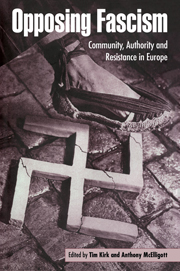Book contents
- Frontmatter
- Contents
- List of contributors
- Preface
- Introduction: Community, authority and resistance to fascism
- 1 The German revolution defeated and fascism deferred: the servicemen's revolt and social democracy at the end of the First World War, 1918–1920
- 2 Dangerous communities and conservative authority: the judiciary, Nazis and rough people, 1932–1933
- 3 The anti-fascist movement in south-east Lancashire, 1933–1940: the divergent experiences of Manchester and Nelson
- 4 Spain 1936. Resistance and revolution: the flaws in the Front
- 5 The Blueshirts in the Irish Free State, 1932–1935: the nature of socialist republican and governmental opposition
- 6 Town councils of the Nord and Pas-de-Calais region: local power, French power, German power
- 7 Structures of authority in the Greek resistance, 1941–1944
- 8 Nazi Austria: the limits of dissent
- 9 ‘Homosexual’ men in Vienna, 1938
- 10 ‘The years of consent’? Popular attitudes and forms of resistance to Fascism in Italy, 1925–1940
- 11 Saints and heroines: rewriting the history of Italian women in the Resistance
- Notes
- Index
2 - Dangerous communities and conservative authority: the judiciary, Nazis and rough people, 1932–1933
Published online by Cambridge University Press: 28 July 2009
- Frontmatter
- Contents
- List of contributors
- Preface
- Introduction: Community, authority and resistance to fascism
- 1 The German revolution defeated and fascism deferred: the servicemen's revolt and social democracy at the end of the First World War, 1918–1920
- 2 Dangerous communities and conservative authority: the judiciary, Nazis and rough people, 1932–1933
- 3 The anti-fascist movement in south-east Lancashire, 1933–1940: the divergent experiences of Manchester and Nelson
- 4 Spain 1936. Resistance and revolution: the flaws in the Front
- 5 The Blueshirts in the Irish Free State, 1932–1935: the nature of socialist republican and governmental opposition
- 6 Town councils of the Nord and Pas-de-Calais region: local power, French power, German power
- 7 Structures of authority in the Greek resistance, 1941–1944
- 8 Nazi Austria: the limits of dissent
- 9 ‘Homosexual’ men in Vienna, 1938
- 10 ‘The years of consent’? Popular attitudes and forms of resistance to Fascism in Italy, 1925–1940
- 11 Saints and heroines: rewriting the history of Italian women in the Resistance
- Notes
- Index
Summary
The transition from a liberal democracy to an authoritarian state in Germany began in 1930 and culminated in 1933 with the establishment of Hitler's dictatorship. A vital component in this process was the courtroom practice of German judges and state prosecutors. The judiciary, guided by its own set of political values and social prejudices, waged a campaign against ‘rough’ working-class communities thought to be the loci of social and political challenge to the authority of the state. In doing so, it found itself in alliance with the Nationalsozialistische Deutsche Arbeiterpartei (NSDAP), itself locked in a struggle for control of such communities.
This chapter explores the complex relationship between judicial authority and communal resistance to nazism. In order to do this, it takes a particular case of political violence from the summer of 1932, the ‘Altona Bloody Sunday’ and its judicial aftermath as illustration. The so-called ‘Altona Bloody Sunday trial’ began on 8 May and ended on 2 June 1933 in death sentences for four of the fifteen defendants. These were the first judicial killings of the Third Reich and anticipate the flood of miscarriages of justice that followed the introduction of the lex van der Lubbe in 1934. But, as we shall see, the ‘Bloody Sunday’ trial was not solely a Nazi miscarriage of justice.
- Type
- Chapter
- Information
- Opposing FascismCommunity, Authority and Resistance in Europe, pp. 33 - 47Publisher: Cambridge University PressPrint publication year: 1999



